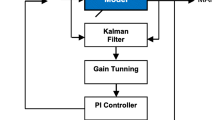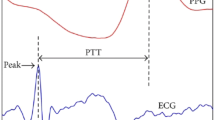Abstract
Linear controllers have been designed to regulate mean arterial pressure (MAP) in treating various cardiovascular diseases. For patients with hemodynamic fluctuations, the MAP control system must be able to provide more sensitive control. Therefore, in this paper, a model predictive control (MPC) approach is presented to improve the sensitivity of MAP control system. The MPC principle can effectively handle the dead times in nonlinear systems, and can also optimize the system responses when subjected to constraints of process states and control signals. Besides, particle swarm optimization (PSO) is employed to solve the optimization problem of MPC at each control interval. According to our simulations, the MAP control system with combined MPC–PSO approach is superior in control qualities to the MAP control system with conventional linear control method. The MPC–PSO MAP control system is possible to be realized through a field-programmable gate array.









Similar content being viewed by others
References
de Moura Oliveira PB, Durães J, Pires EJS (2014) Mean arterial pressure PID control using a PSO-BOIDS algorithm. In: Advances in Intelligent Systems and Computing, pp 91–99
Ferreira A, Boston JR, Antaki JF (2009) A control system for rotary blood pumps based on suction detection. IEEE Trans Biomed Eng 56:656–665
Furutani E, Araki M, Kan S, Aung T, Onodera H, Imamura M, Shirakami G, Maetani S (2004) An automatic control system of the blood pressure of patients under surgical operation. Int J Control Autom Syst 2:39–54
Gao Y, Er MJ (2003) Adaptive fuzzy neural control of mean arterial pressure through Sodium Nitroprusside infusion. In: IEEE 42nd Conf. on Decision and Control, vol. 3, pp 2198–2203
Hoeksel SAAP, Blom JA, Jansen JRC, Maessen JG, Schreuder JJ (2001) Computer control versus manual control of systemic hypertension during cardiac surgery. Acta Anaesthesiol Scand 45:553–557
Holkar KS, Waghmare LM (2010) An overview of model predictive control. Int J Control Autom 3:47–63
Hsu CH, Chang JB, Liu IC, Lau SC, Yu SM, Hsieh CH, Lin JD, Liang YJ, Pei D, Chen YL (2015) Mean arterial pressure is better at predicting future metabolic syndrome in the normotensive elderly: a prospective cohort study in Taiwan. Prev Med 72:76–82
Jeong J, Portnof JE, Kalayeh M, Hardigan P (2016) Hypotensive anesthesia: comparing the effects of different drug combinations on mean arterial pressure, estimated blood loss, and surgery time in orthognathic surgery. J Cranio-Maxillofac Surg 44:854–858
Kennedy J, Eberthart RC (1995) Particle swarm optimization. In: Proc IEEE Int Conf on Neural Networks, vol. 4, pp 1942–1948
Kumar ML, Harikumar R, Vasan AK, Sudhaman VK (2009) Fuzzy controller for automatic drug infusion in cardiac patients. In: Proc. of the International MultiConference of Engineers and Computer Scientists (IMECS 2009), vol. 1, pp 18–20
Lin AY, Huang HN, Su YC, Shiu CY, Hwang JL (2008) Implementation of fuzzy controller for measuring instantaneous arterial blood pressures via tissue control method. IET Control Theory Appl 2:40–50
Liu GZ, Zhang YT, Wang L (2009) A robust closed-loop control algorithm for mean arterial blood pressure regulation. In: 2009 Sixth International Workshop on Wearable and Implantable Body Sensor Networks, pp 77–89
Luginbühl M, Bieniok C, Leibundgut D, Wymann R, Gentilini A, Schnider TW (2006) Closed-loop control of mean arterial blood pressure during surgery with alfentanil clinical evaluation of a novel model-based predictive controller. J Am Soc Anesthesiol 105:462–470
Padmanabhan R, Meskin N, Haddad WM (2015) Closed-loop control of anesthesia and mean arterial pressure using reinforcement learning. Biomed Signal Process Control 22:54–64
Sánchez-Durán JA, Oballe-Peinado Ó, Castellanos-Ramos J, Vidal-Verdú F (2012) Hysteresis correction of tactile sensor response with a generalized Prandtl–Ishlinskii model. Microsyst Technol 18:1127–1138
Sekhon MS, Smielewski P, Bhate TD, Brasher PM, Foster D, Menon DK, Gupta AK, Czosnyka M, Henderson WR, Gin K, Wong G, Griesdale DE (2016) Using the relationship between brain tissue regional saturation of oxygen and mean arterial pressure to determine the optimal mean arterial pressure in patients following cardiac arrest: a pilot proof-of-concept study. Resuscitation 106:120–125
Yang XS (2010) Nature-inspired metaheuristic algorithms. Luniver, Frome, United Kingdom
Zhu KY, Zheng H, Zhang DG (2008) A computerized drug delivery control system for regulation of blood pressure. Int J Intell Comput Med Sci Image Process 2:1–13
Author information
Authors and Affiliations
Corresponding author
Rights and permissions
About this article
Cite this article
Su, TJ., Wang, SM., Vu, HQ. et al. Mean arterial pressure control system using model predictive control and particle swarm optimization. Microsyst Technol 24, 147–153 (2018). https://doi.org/10.1007/s00542-016-3212-9
Received:
Accepted:
Published:
Issue Date:
DOI: https://doi.org/10.1007/s00542-016-3212-9




